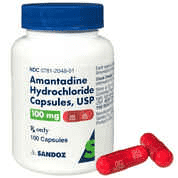As our pets live longer, we see signs of aging, including pain from things like arthritis, back issues and more. Finding medications to safely and effectively keep your pet comfortable is a very important part of helping your againg animal companion. Below is a newer drug that is being used in veterinary medicine.
Amantadine comes under different names: such as brand name like Adekin, Amanta, Amantagamma, Amantan, Amantrel, Amixx, Antadine, Antiflu-Des, Atarin, Atenegine, Cerebramed Endantadine, Infectoflu, Influ-A, Lysovir, Mantadine, Mantadix, Mantidan, Padiken, Symadine, Symmetrel, Viroifral and Virucid.
Amantadine Background

The nervous system involves millions of branching nerve fibers connecting and communicating with one another. The nerve ending of one fiber releases chemicals called neurotransmitters that bind to receptors on nearby nerve fibers. In other words, one nerve sends a chemical message and the other nerve captures and receives it.
This is how nerves communicate with each other. The chemical message may be one of increased or decreased nerve/muscle activity depending on the type of chemical and type of nerve.
Amantadine was first used as an antiviral medication against influenza but it is mainly used now for its ability to inhibit something called an NMDA receptor. The NMDA receptor is a nervous system receptor that can bind to neurotransmitters and create the sensation of pain.

Even worse, this receptor is activated by certain brain chemicals, a stimulus that is normally not painful actually becomes painful. In short, stimulation of the NMDA receptor creates pain and shutting that receptor off helps reduce chronic pain.
When the NMDA receptor is blocked by a medication such as amantadine, chronic pain may be alleviated or reduced. Amantadine alone is not an effective analgesic but when combined with other pain relievers, it adds an extra dimension of pain relief. At this time veterinary experience with this drug is rather limited but it seems to be emerging as a helpful addition to pain relief regimens for dogs and cats.
How this Medication is Used
Typical situations where amantadine might be used:
- Treatment of arthritis pain.
- Treatment of neurologic pain (disk disease, etc.)
- Treatment of pain associated with cancer, especially osteosarcoma a bone tumor.
Amantadine can be given with or without food. It is usually given once or twice daily.
Side Effects
Mild side effects include agitation, gas or diarrhea when first taking it. These should resolve with time. Amantadine also has what are called anticholinergic effects, which include dry mouth (which is seen as increased thirst), retaining urine, and an increased heart rate. These could be problematic when used with medications with similar effects or certain medical conditions.
Overdose in humans has resulted in heart problems, such as abnormal rhythm and high blood pressure, as well as seizures and respiratory distress.
Interactions with other Drugs
It can interact with the antibiotic Trimethoprim-sulfa, quinidine (a heart medication). Additionally, certain diuretics may decrease the excretion of amantadine, resulting in higher levels in the system, making amantadine stronger.
Other drugs such as antihistamines may enhance certain effects of amantadine, including dry mouth (possibly showing as more lip-licking or water consumption), difficulty urinating, increased heart rate.
Other drugs that increase activity/general stimulation may exacerbate the agitation side effect sometimes seen with amantadine. Selegiline, which is frequently used to treat senile cognitive dysfunction, might be an unexpected member of this category of drugs.
Concerns and Cautions
Probably the biggest concern is that this medication is fairly new to veterinary use and a full catalog of what to expect with its use is not yet available. Right now amantadine is growing in popularity for pets and may prove to be an excellent complement to many pain relief regimens.
In human medicine caution is recommended when considering its use in patients with kidney disease, seizure disorders, active psychoses, liver disease, or congestive heart failure. This means that side effects are more likely in these situations.
Two take home considerations:
- Amantadine is best used in conjunction with other pain relievers and requires at least a week of use before its effectiveness can be judged.
- Amantadine has a narrow therapeutic range, which means accurate dosing is important to avoid toxicity. Use of oral liquid formulations allow for more accurate dosing.


